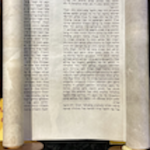Today in my Sunday school class (which has been studying John’s Gospel) we reached the beginning of John chapter 8, the story of the woman caught in adultery. The story itself is one of the most famous stories about Jesus there is. Yet among New Testament scholars, the story is famous for other reasons.
The textual evidence, although strongly suggestive that the first 11 verses of John 8 did not originally belong to this Gospel, are intriguing. The earliest manuscripts omit the passage, but they also tend to include a dot or space indicating awareness of copies that add something there. Later, we have manuscripts that include this story, and they too signal that they are aware of copies of the Gospel that lack it, using similar devices.
The story’s inclusion here is readily intelligible, independent of questions about who was responsible. The story provides a nice jumping-off point for the symbolism of testimony and spiritual illegitimacy found later in the chapter.
When it comes to the interpretation of the story, it is important to note that the Pharisees (as both Josephus and later rabbinic literature show) were characterized by concern to avoid capital punishment whenever possible. In view of this, it seems most likely that their test of Jesus would have been to see whether and how he could find an appropriate loophole and avoid a death sentence. In typical fashion, Jesus does not engage in a quest for loopholes in the law, or even point out the irregularity of the situation (as though the woman could have been caught in the act of adultery on her own!), but appeals to a broader moral principle. That principle of judging others as we would want to be judged ourselves is of course attributed to Jesus elsewhere.
The majority scholarly judgment that this story was probably not originally part of John’s Gospel is sound, if not absolute. And so Christian readers must ask the question whether the authority of this story lies in its being an authentic piece of historical recollection, or an original part of a book included in the canon of Scripture. Those of us concerned to promote Christians being better informed about the processes that go into producing an English-language translation of the Bible should be grateful for this pericope, which brings such problems up into the text rather than allowing them to be ignored with all the other footnotes.
In closing this blog entry, I’d like to suggest that the story be regarded as self-authenticating. We will never be certain that this story reflects a real incident in the life of Jesus (although its inclusion can be argued to reflect a widespread knowledge of the story which demanded it be committed to writing and included, which could support its authenticity). We will never be certain it was an original part of John’s Gospel (although we might have sufficient grounds to feel certain that it wasn’t). But in the end, the story’s challenge to our tendency to point fingers at others rather than acknowledge our own failings and shortcomings does not need to be attributed to a particular person in order to be challenging.
Discussing the technical scholarly issues is crucially important, since without such discussions, people can treat difficult questions as though they are easy or even non-existent. But in the end it is important also to read the story and hear its message, and then to do with it what we will. The cultural context is noticeably different (in the U.S. nowadays we would not have a posse apprehending an adulteress and enacting vigilante justice – more or less the only kind there was in the ancient world), and such details likewise ought not be ignored, but they do not, in the end, prevent us from hearing the challenge of this story addressing us across the ages in a way that seems to have lost none of its force or meaning.












